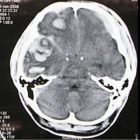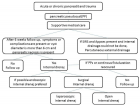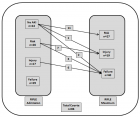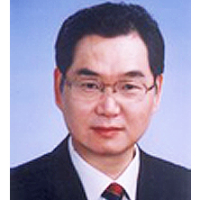Abstract
Research Article
Study of kabul river canal sediments for heavy metals status and its accumulation in wheat plant (triticum aestivum)
Mohammed Nafees* and Asma Amin
Published: 21 April, 2023 | Volume 7 - Issue 1 | Pages: 049-053
Canal cleaning is a routine activity on the canals diverted from the Kabul River. As a result, thousands of tons of sediment are removed as sludge and flushed back into the Kabul River. In Peshawar city, most people use this sediment as a soil conditioner in lawns. But the farmers are hesitant to apply it in agricultural fields. It is perceived that the sediment may be rich in heavy metal contents and, if used as a soil conditioner, may contaminate the food chain. To unveil the facts, this study was conducted with the aim of analyzing sediment samples for selected heavy metals and their uptake and accumulation in different parts of the wheat plant. For this purpose, the sediment collected from Warsak Gravity Canal (WGC) was analyzed for total essential heavy metals including iron (Fe), copper (Cu), cobalt (Co), manganese (Mn), and Zinc (Zn). Wheat crop was grown in four different pots consisting of pure soil, pure sediment, and two amendments i.e. soil mixed with 25% and 50% sediments. In comparison to sediment, the soil samples were high in copper, cobalt, and Zinc concentration. The concentration of iron and manganese was comparatively high in pure sediment but within permissible limits. The heavy metals uptake by the wheat crop was also within the permissible limits. The highest accumulation of copper, iron, and Zinc was observed in the roots of wheat plants. The highest value of cobalt was observed in the seed (0.407 mg Kg-1), which was within the safe range. Therefore, it is concluded that the sediment of the Kabul River canal cannot be considered a source of pollution in terms of heavy metals and can be used as a soil conditioner.
Read Full Article HTML DOI: 10.29328/journal.afns.1001049 Cite this Article Read Full Article PDF
Keywords:
Heavy metals; Bioaccumulation; Sediment; Wheat crop; Warsak gravity canal
References
- Nafees M, Ahmad F, Butt MN, Khurshed M. Effects of water shortage in Kabul River network on the plain areas of Khyber Pakhtunkhwa, Pakistan. Environ Monit Assess. 2018 May 24;190(6):359. doi: 10.1007/s10661-018-6730-3. PMID: 29799074.
- Nafees M. Environmental Study of Kabul River and its Tributaries in Khyber Pakhtunkhwa. Pakistan. M. Phil Thesis. Department of Environmental Sciences, University of Peshawar. 2004.
- Iqbal MZ. To assess the Water Supply and Demand for Pabbi minor at Pabbi for Rabi season. (Unpublished) M.Sc. (Hons) Thesis. Dept: of Water Management, N.W.F.P Agriculture University Peshawar. 1995.
- Nafees M. Role of Kabul River in Socio-economic Activities and Associated Environmental Problems. Journal of Area Study Center, University of Peshawar. 2010; 67(1): 101-112.
- IUCN-DEPM. Pollution and the Kabul River, an Analysis and Action Planning. A joint Publication of International Union for Conservation of Nature and Natural Resources (IUCN)and Department of Environmental Planning and Management (DEPM), UOP, published by Environment and Development Department Civil Secretariat, Khyber Pakhtunkhwa, Pakistan. 1994.
- Mussarat M,Bhatti AU , Khan FU. Concentration of metals in sewage and canal water used for irrigation in Peshawar. Sarhad J Agric. 2007; 23(2): 335-338.
- Saeed TU, Khan TA. Impact of water losses and maintenance of canal irrigation system on agriculture (case study: Urmar Minor of Warsak Gravity Canal Pakistan). American Journal of Experimental Agriculture. 2014; 4(5): 550-562.
- Shabir A, Rehman H, Naseem J. Sediment Analysis of Warsak Gravity Canal. Journal of Emerging Trends in Applied Engineering. 2016; 1(2):17-21
- Shabir AK, Nafees M. Construction of Dams on Kabul River and Its Socio-Economic Implications for Khyber Pakhtunkhwa, Pakistan. Central Asia Journal. 2018; 83(1)1-18.
- Colbeck I, Nasir ZA, Ali Z. Characteristics of indoor/outdoor particulate pollution in urban and rural residential environment of Pakistan. Indoor Air. 2010 Feb;20(1):40-51. doi: 10.1111/j.1600-0668.2009.00624.x. Epub 2009 Sep 11. PMID: 20028432.
- Wenchuan Q, Dickman M, Sumin W. Multivariate analysis of heavy metal and nutrient concentrations in sediments of Taihu Lake China*. Hydrobiologia. 2001; 450(1-3): 83-89.
- Walling DE, Owens PN, Carter J, Leeks GJL, Lewis S, Meharg AA, Wright J. Storage of sediment-associated nutrients and contaminants in river channel and floodplain systems. Applied Geochemistry. 2003; 18(2):195-220.
- Gherardi MJ, Rengel Z. Micronutrient deficiencies and their correction. 18th North America Conference on Symbiotic Nitrogen Fixation. 2003; 257 (1): 85-95.
- Canet R, Chavez C, Pomares F, Albiach R. Agricultural use of sediments from the Albufera Lake (eastern Spain). Agriculture Ecosystem and Environment. 2003; 95(1):29-36.
- Olson KR, Jones RL. Agronomic use of scrubber sludge and soil as amendments to Lake Springfield sediment dredgings. J Soil Water Conserv. 1987; 42(1):57-60.
- Diaz RD, Darmody R. Illinois River Dredged Sediment and Biosolids Used as Greenhouse Soil Mixtures, MSc Thesis, Department of Natural Resources and Environmental Sciences, University of Illinois Urbana-Champaign. 2004.
- Finck A. Soil nutrient management for plant growth. In Warkentin, B. P (Eds) “Footprints in the Soil”, Chapter 16, IUSS, Holland. 2006.
- Wang Q, Dong Y, Cui Y. Instances of soil & crop heavy metal contamination in China. Soil and Sediment Contamination. 2001; 10 (5):582-591.
- Martens DC. Westermann DT. Fertilizer applications for correcting micronutrient deficiencies. In Manzoor AS, Raza S. “Micronutrient Fertilizer” Pakistan Journal of Biological Sciences. Asian Network for Scientific Information. 1991; 4 (11):1446-1450.
- Reed ST, Allen MG, Martens DC, McKenna JR. Copper fractions extracted by Mehlich-3 from soils amended with either CuSO4 or copper rich pig manure. Commun Soil Sci. 1993; 24(9-10):827-839.
- Jeffrey G, Jacobsen J, Bauder W. Soil testing Procedure, Interpretation and Fertilizer Sources. USDA Agriculture Research Services Publication No. MT 8704-5: 2004.
- Yruela L. Copper in plants. Brazilian Journal of Plant Physiology. 2005; 17(1): 145-156.
- Islam Eu, Yang XE, He ZL, Mahmood Q. Assessing potential dietary toxicity of heavy metals in selected vegetables and food crops. J Zhejiang Univ Sci B. 2007 Jan;8(1):1-13. doi: 10.1631/jzus.2007.B0001. PMID: 17173356; PMCID: PMC1764924.
- Rattana RK, Dattaa SP, Chhonkara PK, Suribabua K, Singhb AK. Long-term impact of irrigation with sewage effluents on heavy metal content in soils, crops and groundwater-a case study. Agriculture, Ecosystems & Environment. 2005; 109(3-4): 310-322.
- Hough RL, Young SD Crout NMJ. Modeling of Cd, Cu, Ni, Pb and Zn uptake, by winter wheat and forage maize, from a sewage disposal farm. Soil Use and Management. 2003; 19(1):19-27.
- Jia L, Wang W, Li Y, Yang L. Heavy metals in soil and crops of an intensively farmed area: a case study in Yucheng City, Shandong Province, China. Int J Environ Res Public Health. 2010 Feb;7(2):395-412. doi: 10.3390/ijerph7020395. Epub 2010 Feb 1. PMID: 20616981; PMCID: PMC2872287.
- Ullah Z, Nafees M. Effects of Aman Garh Industrial Estate on Water Quality of Kabul River Khyber PukhtoonKhawa. 2010.
- Rauf A, Javed M, Ubaidullah M. Abdullah S. Assessment of Heavy Metals in Sediments of the River Ravi, Pakistan. International Journal of Agriculture & Biology. 2009; 11(2):197-200.
- Mehlich A. Mehlich-3 soil test extractant: a modification of Mehlich-2extractant. Commun Soil Sci Plant Anal. 1984; 15(12):1409-1416.
- Khan A, Ali M. Impact of built environment on groundwater depletion in Peshawar, Pakistan. Journal of Himalayan Earth Sciences. 2019: 52(1): 86.
- Basit A, Amin NU, Shah ST, Ahmad I. Greenbelt conservation as a component of ecosystem, ecological benefits and management services: evidence from Peshawar City, Pakistan. Environment, Development and Sustainability. 2021; 1-25.
- Quansah WG. Effect of organic and inorganic fertilizers and their combinations on the growth and yield of maize in the semi-deciduous forest zone of Ghana. MS. Thesis, Department of Crop and Soil Sciences, College of Agriculture and Natural Resources, Kwame Nkrumah University of Science and Technology, Kumasi, Ghana. 2010.
- Rowell DL. Soil Science method and applications: Pesticides and Metals. Longman Singapore Publisher (Ptc) Ltd. Singapore. 1994.
- Huang JS, Wei DP, Guo XY, Ma YB. [Toxicity and accumulation of copper and nickel in wheat plants cropped on alkaline and acidic field soils]. Huan Jing Ke Xue. 2012 Apr;33(4):1369-75. Chinese. PMID: 22720591.
- Young SY. Solubility of cobalt in soil. Journal of soil sciences. 1955; 6(2):233-240.
- Bakkaus E, Gouget B, Gallien JP, Khodja H, Carrot F, Morel JL, Collins R. Concentration and distribution of cobalt in higher plants: The use of micro-PIXE spectroscopy. Nuclear Instruments and Methods in Physics Research Section B: Beam Interactions with Materials and Atoms. 2005; 231(1): 350-356.
- European Commission Director General Environment (ECDGE) 2004. Heavy Metals and Organic Compounds from Wastes Used as Organic Fertilizers, Final Report, URL: http://ec.europa.eu/environment/waste/compost/ pdf/hm_finalreport.pdf.
- Gerwing J. Gelderman R. Fertilizer Recommendation Guide. Cooperative extension service, South Dakota State University, U.S department of Agriculture. 23: 2005; http://plantsci.sdstate.edu.
- Alloway B. Zinc - The Vital Micronutrient for Healthy, High-Value Crops. International Zinc Association (IZA), 168 Avenue de Tervueren, 1150 Brussels - Belgium, Internet: ww.zincworld.org .2002.
- Sabiha J, Mehmood T, Chaudhry MM, Tufail M, Irfan N. Heavy metal pollution from phosphate rock used for the production of fertilizer in Pakistan, Microchemical Journal. 2009; 91(1):94-99.
- Manzoor AS, Raza S. Micronutrient Fertilizers Pakistan Journal of Biological Sciences. Asian Network for Scientific Information. 2001; 4(11):1446-1450.
Figures:
Similar Articles
-
Study of kabul river canal sediments for heavy metals status and its accumulation in wheat plant (triticum aestivum)Mohammed Nafees*, Asma Amin. Study of kabul river canal sediments for heavy metals status and its accumulation in wheat plant (triticum aestivum). . 2023 doi: 10.29328/journal.afns.1001049; 7: 049-053
-
Evaluation of Heavy Metals in Commercial Baby FoodsOmobolanle David Garuba, Judith C Anglin, Sonya Good, Shodimu-Emmanuel Olufemi, Olubukola Monisola Oyawoye, Sodipe Ayodotun*. Evaluation of Heavy Metals in Commercial Baby Foods. . 2024 doi: 10.29328/journal.afns.1001056; 8: 012-020
Recently Viewed
-
Leiomyosarcoma in pregnancy: Incidental finding during routine caesarean sectionToon Wen Tang*,Phoon Wai Leng Jessie. Leiomyosarcoma in pregnancy: Incidental finding during routine caesarean section. Clin J Obstet Gynecol. 2021: doi: 10.29328/journal.cjog.1001094; 4: 092-095
-
Adult Neurogenesis: A Review of Current Perspectives and Implications for Neuroscience ResearchAlex, Gideon S*,Olanrewaju Oluwaseun Oke,Joy Wilberforce Ekokojde,Tolulope Judah Gbayisomore,Martina C. Anene-Ogbe,Farounbi Glory,Joshua Ayodele Yusuf. Adult Neurogenesis: A Review of Current Perspectives and Implications for Neuroscience Research. J Neurosci Neurol Disord. 2024: doi: 10.29328/journal.jnnd.1001102; 8: 106-114
-
Late discover of a traumatic cardiac injury: Case reportBenlafqih C,Bouhdadi H*,Bakkali A,Rhissassi J,Sayah R,Laaroussi M. Late discover of a traumatic cardiac injury: Case report. J Cardiol Cardiovasc Med. 2019: doi: 10.29328/journal.jccm.1001048; 4: 100-102
-
A two-phase sonographic study among women with infertility who first had normal sonographic findingsKalu Ochie*,Abraham John C. A two-phase sonographic study among women with infertility who first had normal sonographic findings. Clin J Obstet Gynecol. 2022: doi: 10.29328/journal.cjog.1001117; 5: 101-103
-
Sinonasal Myxoma Extending into the Orbit in a 4-Year Old: A Case PresentationJulian A Purrinos*, Ramzi Younis. Sinonasal Myxoma Extending into the Orbit in a 4-Year Old: A Case Presentation. Arch Case Rep. 2024: doi: 10.29328/journal.acr.1001099; 8: 075-077
Most Viewed
-
Evaluation of Biostimulants Based on Recovered Protein Hydrolysates from Animal By-products as Plant Growth EnhancersH Pérez-Aguilar*, M Lacruz-Asaro, F Arán-Ais. Evaluation of Biostimulants Based on Recovered Protein Hydrolysates from Animal By-products as Plant Growth Enhancers. J Plant Sci Phytopathol. 2023 doi: 10.29328/journal.jpsp.1001104; 7: 042-047
-
Sinonasal Myxoma Extending into the Orbit in a 4-Year Old: A Case PresentationJulian A Purrinos*, Ramzi Younis. Sinonasal Myxoma Extending into the Orbit in a 4-Year Old: A Case Presentation. Arch Case Rep. 2024 doi: 10.29328/journal.acr.1001099; 8: 075-077
-
Feasibility study of magnetic sensing for detecting single-neuron action potentialsDenis Tonini,Kai Wu,Renata Saha,Jian-Ping Wang*. Feasibility study of magnetic sensing for detecting single-neuron action potentials. Ann Biomed Sci Eng. 2022 doi: 10.29328/journal.abse.1001018; 6: 019-029
-
Pediatric Dysgerminoma: Unveiling a Rare Ovarian TumorFaten Limaiem*, Khalil Saffar, Ahmed Halouani. Pediatric Dysgerminoma: Unveiling a Rare Ovarian Tumor. Arch Case Rep. 2024 doi: 10.29328/journal.acr.1001087; 8: 010-013
-
Physical activity can change the physiological and psychological circumstances during COVID-19 pandemic: A narrative reviewKhashayar Maroufi*. Physical activity can change the physiological and psychological circumstances during COVID-19 pandemic: A narrative review. J Sports Med Ther. 2021 doi: 10.29328/journal.jsmt.1001051; 6: 001-007

HSPI: We're glad you're here. Please click "create a new Query" if you are a new visitor to our website and need further information from us.
If you are already a member of our network and need to keep track of any developments regarding a question you have already submitted, click "take me to my Query."
















































































































































